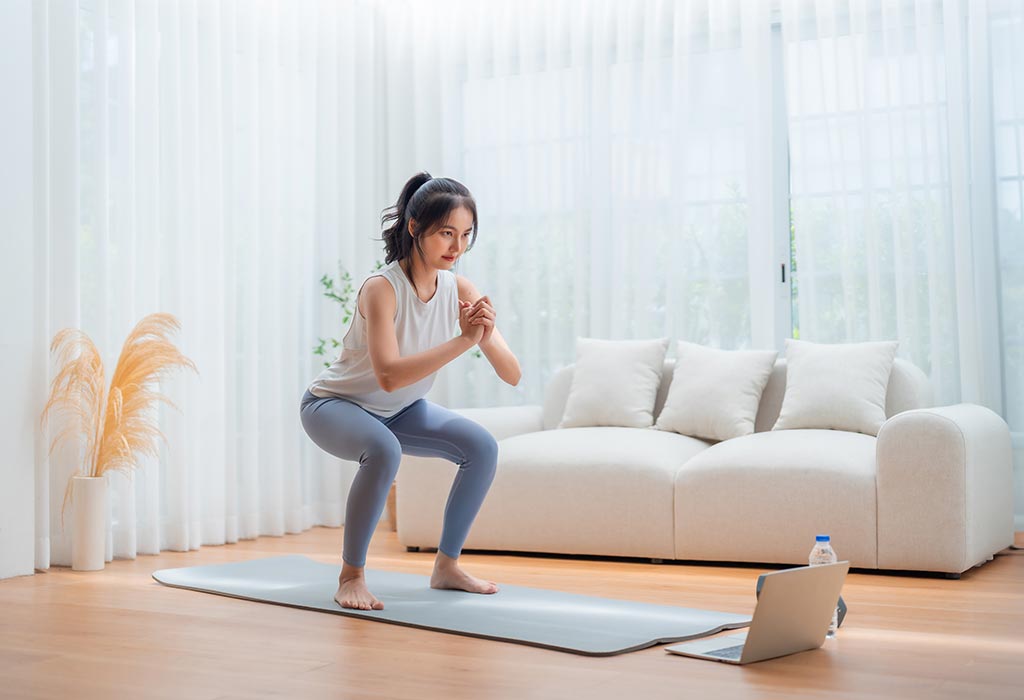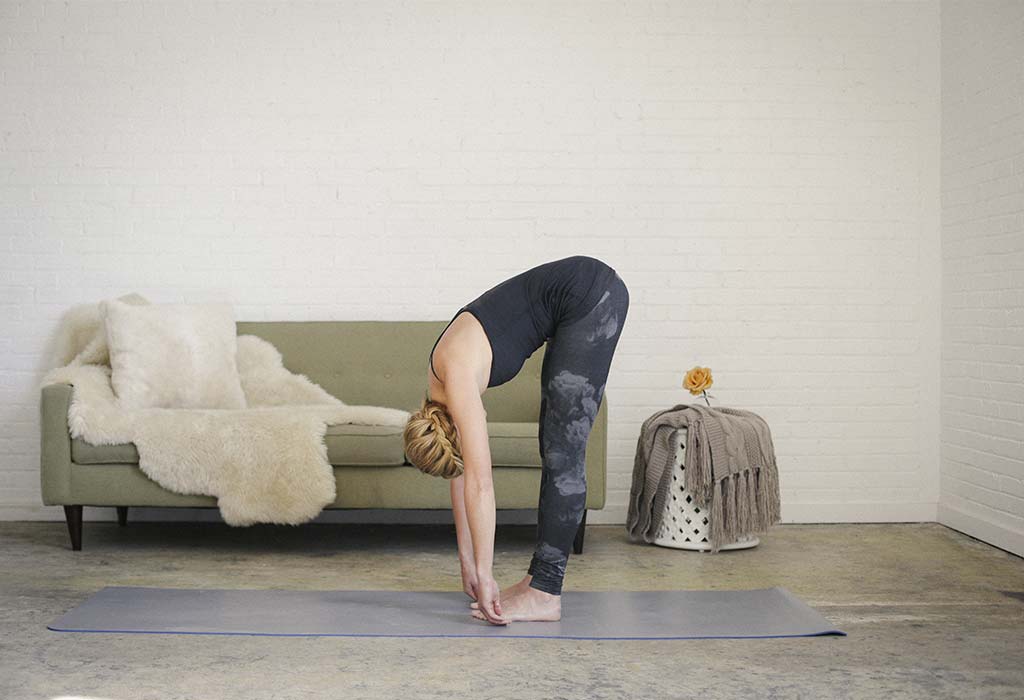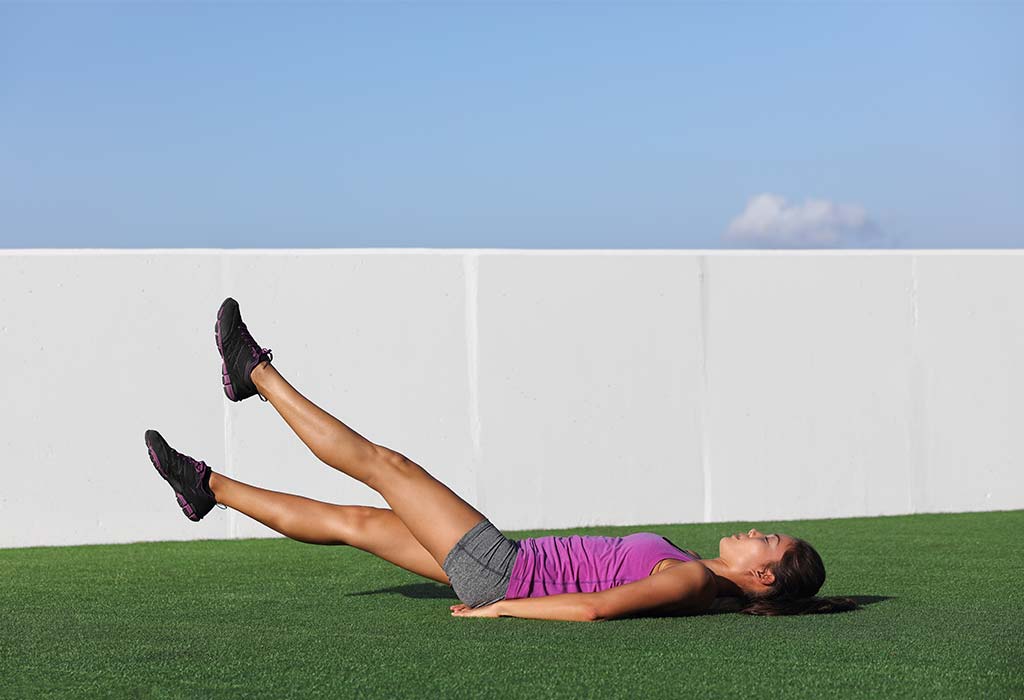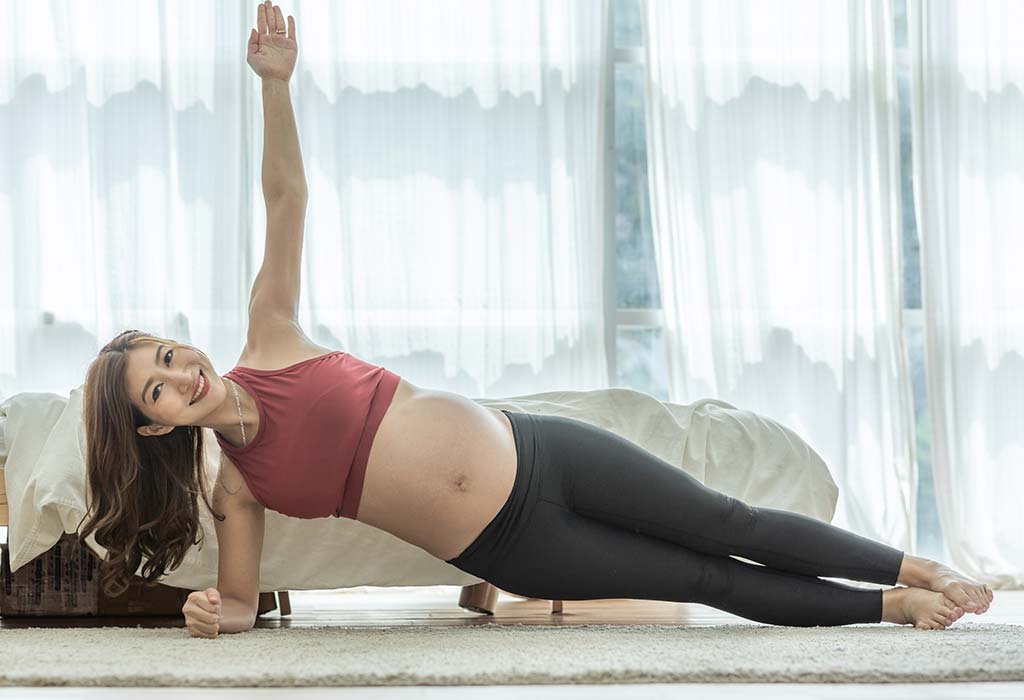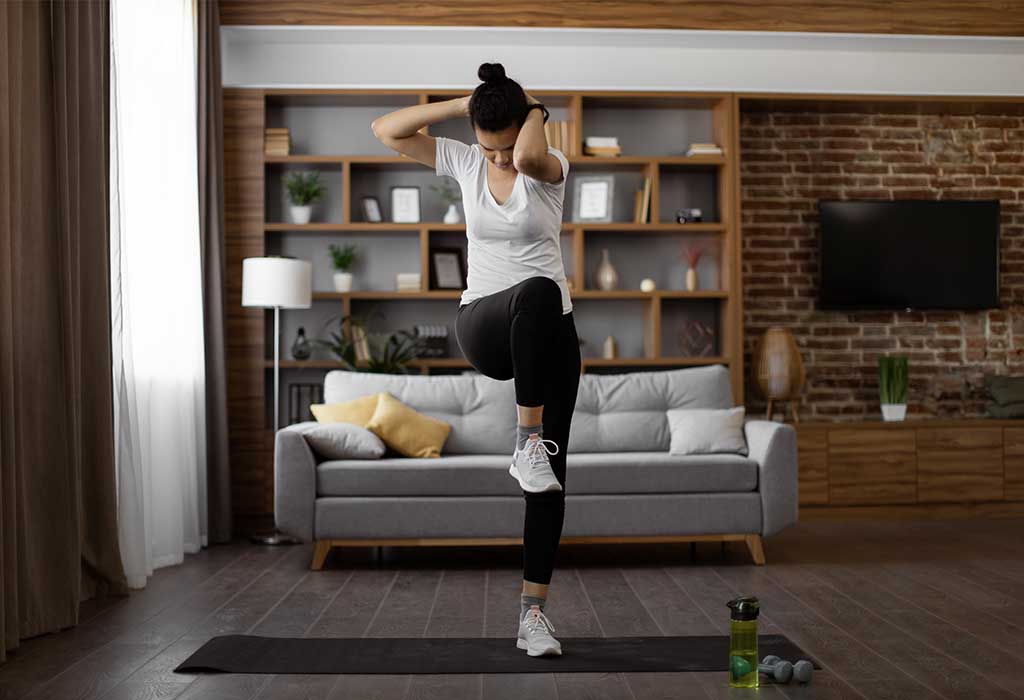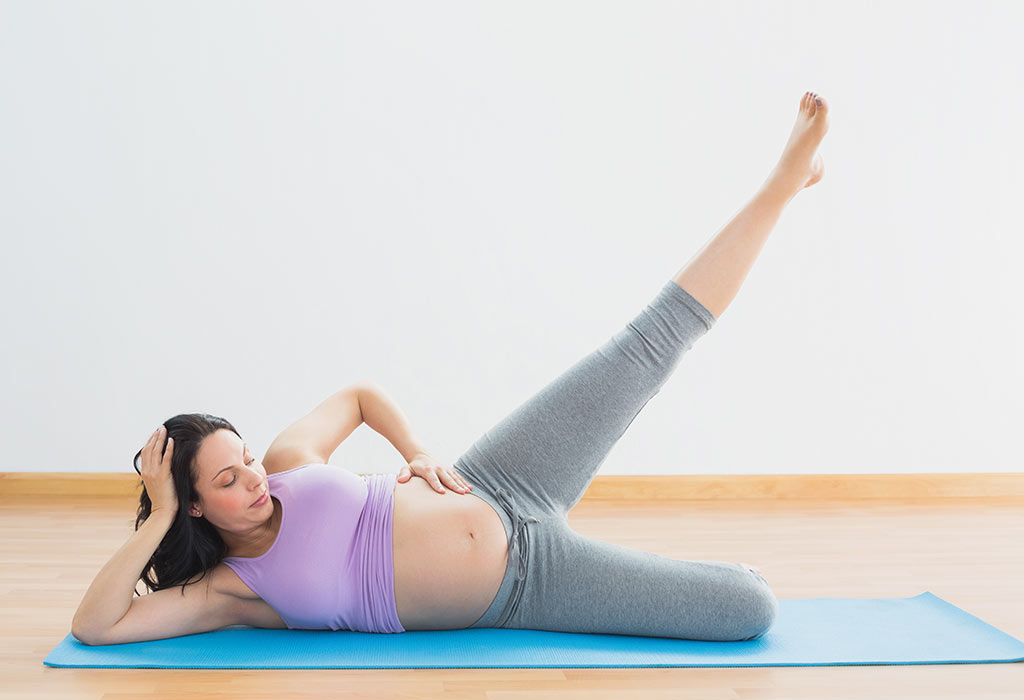20 Safe Abdominal Exercises To Do During Pregnancy
Disclaimer: Always consult your doctor whether it is safe for you to exercise during your pregnancy.
A pregnant woman has to endure a lot of pain, which cannot be described in words. The abdominal muscles of a pregnant woman stay in a stretching mode from the beginning of the pregnancy to the delivery in order to accommodate the baby. Abdominal exercises come to the rescue when you wish to ease the process of such stretching without any complications. Also, abdominal exercises during pregnancy should be practised to ensure a smooth and pain-free delivery.
While doing these exercises, one should always note which part of the body will be affected by these abdominal exercises and what benefit it carries. All these muscles are generally prone to weakness, and this is where abdominal exercises assist in strengthening them. Having discussed the whys of abdominal exercises, let’s carry the discussion forward with the safe exercises for gaining abdominal strength during pregnancy.
Is it Safe to Do Abdominal Exercises in Pregnancy?
Yes, many abdominal exercises are safe during pregnancy if done correctly and under the guidance of a professional. They help strengthen core muscles, improve posture, and reduce back pain. However, avoid exercises that require lying flat on your back for extended periods, especially after the first trimester (1).
Safe Abdominal Exercises for Pregnant Women
Safe abdominal exercises for pregnancy are discussed below but do not forget to consult your doctor before going ahead with these exercises.
1. Sitting Knee Lift
This exercise can be easily done with the help of a chair and is known to be good for stimulating your abdominal muscles.
How to Do:
- Sit on the edge of a stable chair.
- Keep your feet flat on the ground, just beneath your knees.
- Keep an exercise band or any band on your thighs and hold it with your hands on either side of the chair seat.
- Lift your left leg slowly in an upward direction against the band and slowly contract your abdomen until your pelvis tilts.
- In case your abdominal muscles start feeling even a bit tight, stop immediately.
- Place your left leg back on the ground and repeat the exercise with your right leg.
2. Core Breathing
This abdominal exercise is the simplest of all and can be done anywhere without much exertion.
How to Do:
- Sit cross-legged comfortably and maintain a straight back posture.
- Place both of your hands on your waist, i.e. on your ribs on either side and relax completely, try to stay calm.
- Take a deep breath and open the ribs in an outward direction.
- Now exhale gradually and bring your ribs back to the normal arrangement.
3. Seated Ball Stability Hold
For performing this exercise, you would need a stability ball.
How to Do:
- Sit on the stability ball with your back posture straight.
- For maintaining balance, you may also put both your hands on either side of the ball.
- Once you feel relaxed and comfortable, take a deep breath involving your core.
- Lift up your left foot off the ground and raise your opposite arm, i.e. the right arm up in the air.
- Hold your breath in this position for 2-3 seconds and then exhale gradually returning back to your normal position.
- Repeat the exercise with your opposite foot and arm.
4. Standing Pelvic Tilt
This exercise is helpful in keeping your posture straight and helps in reducing the backache problems during pregnancy. This exercise also helps in strengthening your abdominal muscles (1).
How to Do:
- Do this exercise against a wall of your house, as it will help you feel the resistance and you will know when to stop.
- Maintain a straight posture when standing against the wall and your back and hips should touch the wall.
- Keep your feet a bit away from the wall, i.e. they shouldn’t be touching the wall.
- Using your hand feel the small distance between your lower back and the wall so as to make sure that your lower back does not touch the wall.
- Now take a deep breath from your core, keep your breath intact for 2-3 seconds and then exhale slowly so that your lower back pushes against the wall.
- Repeat this exercise for 10-15 times as per your comfort level.
5. Kegels
Kegels has numerous benefits. Kegels helps in keeping your pubococcygeal muscle in shape which in turn helps in normal urine flow, provides support to the growing fetus, and helps tone the vaginal muscles. It also assists in normal delivery and helps in averting haemorrhoids (2).
How to Do:
- Sit down comfortably on a stability ball. Once you feel relaxed and comfortable, inhale slowly to your full capacity so that your belly rises due to the air inhaled.
- Now exhale slowly and let all the inhaled air out.
- One thing that you should keep in mind is to keep your inhale duration equal to your exhale duration.
- During your next inhalation and exhalation session, contract your vaginal muscles hard in the same manner as you do when you have a strong urge to pee but resist.
- Now contract your pelvic floor muscles, and hold that pose for 8-10 seconds before releasing the pressure on the muscles.
- Repeat the exercise several times in a day’s time and increase the count once you become a pro at it.
6. Squats
Squats help in reducing the complications during pregnancy and also help you in your labour time (3).
How to Do:
- Stand in a straight position with your feet wide apart.
- Stretch your arms straight in front of your chest.
- Slowly squat down in the same position maintaining your balance in the right way.
- While you squat down, maintain your shoulders, abs, and back in such a way that you feel the pressure at the mentioned particular points.
- Get back to your normal position and repeat this exercise for at least 10 times.
7. Side-Lying Leg Lifts
This exercise is known to be good for supporting your glute and lower back muscles.
How to Do:
- Lie down on your left side on a mat with your feet crossed at the ankle.
- Insert your left hand under your head, and your left elbow rested on the floor so that your body gets support.
- While maintaining the mentioned position, lift up your right leg in the air as high as you can. Do not bend your leg; raise it in a straight fashion.
- Lower your left leg and bring it down near to your right leg.
- Repeat this exercise with the other leg and keep on repeating the exercise until you feel tired.
8. Bird Dog
This type of exercise helps in maintaining the abdominal strength.
How to Do:
- Spread a mat and get down on your knees on the mat, maintain a stable position.
- Now bend down in such a way that your wrists rest directly under your shoulders in a forward direction.
- Now keeping your back in an upright posture and your abdominal muscles tight, raise your left leg up in the air and stretch it in a straight line right behind you.
- Now raise your right arm in the air too and extend it in a straight direction right in front of you.
- Hold the position for 3-4 seconds and slowly come back to your relaxed position.
- Repeat the exercise with the opposite leg and arm.
9. Standing Toe Touch
This exercise helps in lessening the stress on your lower back and in enhancing your flexibility which would in turn later help in a smooth delivery.
How to Do:
- Stand in a straight posture with your legs placed wide apart.
- Put your hands right behind your head.
- Now bend down in such a way that your arms come closer to one another.
- Bend down as much as possible without putting much stress on your abdomen.
- Repeat the exercise 8-10 times.
10. Standing Bicycle
This exercise helps in enhancing your balance and builds your overall strength.
How to Do:
- Stand in a straight posture, keep your feet wide apart.
- Keep your hands behind your head.
- Crunch in the forward direction and move your right leg towards your chest.
- Twist in such a fashion so that your right knee touches your left elbow.
- Repeat the exercise with your other leg and elbow.
11. Single Heel Drop
This exercise is safer than other abdominal exercises done during pregnancy.
How to Do:
- Lie down on a mat with your back on the ground and hands on either side.
- Bend your knees in an inward direction so that your feet are placed right beneath your hips.
- Lift one foot at a time and extend it in straight fashion in the front direction.
- Slowly bring back your leg and repeat with the other leg.
12. Cat-Cow Pose
This exercise helps in enhancing your flexibility, particularly of the spine area (4).
How to Do:
- Get down on a mat on your hands and knees.
- Place your hands right under your shoulders and your knees right under your hips.
- Begin inhaling in a calm manner and gaze towards the roof and at the same time arch your back.
- Now exhale while tucking in your chin and pulling in the abdomen tighter.
- Repeat the exercise 10-15 times.
13. Scissor Kicks
This exercise is recommended during the first trimester of your pregnancy.
How to Do:
- Lie down on a mat in a straight manner and place both the hands beneath your buttocks.
- Raise your left leg to about 10 inches in a gradual manner.
- Lower the left leg and raise the right leg in the same fashion.
- Repeat the exercise at least 8-10 times, rest in between and start over again.
14. Hip Hiker
This exercise adds support to your lower back and the glute muscles.
How to Do:
- Lie down on a mat on either of your sides with your legs on top of each other.
- Bend your lower leg while keeping your other leg straight.
- Lift your top leg above the ground for about 3-4 inches.
- Keep the raised leg straight while pulling your hip muscles tight.
- Maintain the position for about 10 seconds and then repeat with the other side.
15. No Crunch Crunches
This exercise helps in improving the strength of abdominal muscles.
How to Do:
- Lie down on a mat with your back on the floor.
- Bend your knees so that they are right under your hips.
- Put your hands on either side of your belly.
- In a gentle manner press two fingers of either hand on your lower abdominal area.
- Now gently push down your fingers on the lower abdominal area. While you do this try not to move your pelvis.
- When you feel that your abdominal muscles start tightening, discontinue the exercise.
- Repeat the exercise 10-15 times.
16. Side Plank
The side plank helps target the obliques and deep core muscles while improving overall core strength.
How to Do:
- Lie on your side with your elbow directly under your shoulder.
- Lift your hips off the ground, keeping your knees bent for support.
- Hold the position for 10-20 seconds, then switch sides.
- Repeat 3-5 times per side.
17. Standing Crunch
The standing crunch is a great way to engage your abdominal muscles while maintaining an upright posture. It helps tone the core and obliques without the need to lie down, making it a convenient exercise for pregnant women.
How to Do:
- Stand straight with your feet hip-width apart, knees slightly bent for stability.
- Place your hands gently behind your head and draw your elbows outward.
- Pull in your belly button and gently tuck your pelvis.
- Slowly bend forward from your waist, bringing your elbows down toward your knees while squeezing your abdominal muscles.
- Return to the starting position with control and repeat for 15 to 20 repetitions.
18. Seated Spinal Circles
Seated spinal circles are a gentle and effective exercise that helps improve spinal mobility and strengthen your core. This exercise can also alleviate tension in your lower back and promote better posture, making it a great option during pregnancy.
How to Do:
- Sit on an exercise ball with your feet flat on the floor and hands resting on your thighs, just above your knees.
- Slowly rotate your pelvis in a circular motion, allowing your spine to follow the movement.
- Move in one direction for five slow and controlled circles, focusing on your core.
- Switch directions and repeat for another five circles.
19. Wall Plank
This is a simple variation of the traditional plank, providing core activation while reducing pressure on the abdomen.
How to Do:
- Stand about 2 feet away from a wall, feet hip-width apart.
- Place your palms flat on the wall, shoulder-width apart, and at chest height.
- Slowly lean forward, keeping your body in a straight line from your head to your heels.
- Hold the position for 10-20 seconds.
- Gradually return to a standing position.
- Repeat 5-8 times.
20. Side-Lying Hip Bridge (Modified)
This exercise strengthens the core and hip muscles while being easy on the back and abdomen.
How to Do:
- Lie on your side with your knees bent at a 90-degree angle and your legs stacked.
- Rest your head on your lower arm, and place your top hand on the floor in front of you for balance.
- Squeeze your glutes and lift your hips off the ground, forming a straight line from your knees to your shoulders.
- Hold the position for 3–5 seconds, then lower your hips slowly.
- Repeat 8–10 times on each side.
Benefits of Doing Abdominal Exercises in Pregnancy
The major benefits of doing ab workouts during pregnancy include (5):
- Helps in marinating overall fitness and even keeps your mood elevated
- Helps in building flexibility of the muscles
- Helps in maintaining an upright posture
- Helps in lessening the body pains and cramping
- Helps in smoothening the labour process
- Helps in speedy and timely recovery post delivery
- Ensures improvement in your baby’s health
Safety Tips While Performing Abdominal Exercises
The things to keep in mind while doing abdominal workout during pregnancy include (1):
- You may exercise more during your first trimester, but reduce these exercises after the second and third trimester.
- After your first trimester, avoid exercising by lying on your back.
- Drink enough water to keep you stay hydrated.
- Avoid doing exercise beyond your strength or any exercise that puts stress on your abdomen.
- If you are new to exercising, start doing it for up to 5 minutes and extend the duration gradually.
- Stop doing the exercise immediately in case you feel stress or pain in your abdominal area, or you feel a gradual increase in your heart rate.
- All these exercises are to be done only when someone is at home/nearby just in case of emergencies, especially in the later stage of pregnancy.
FAQs
1. Can I continue my pre-pregnancy core workouts?
You may continue modified versions of your pre-pregnancy core workouts, as long as they are low-impact and avoid lying flat on your back or performing intense twisting movements. Always consult your doctor before resuming any pre-pregnancy routine.
2. How often should I do abdominal exercises while pregnant?
It’s generally safe to include core exercises 2–3 times a week for about 10–15 minutes per session. Listen to your body and avoid overexertion. If you feel any discomfort, stop immediately.
Ab workout and pregnancy can go hand in hand when performed with safe and modified exercises that support the changing body and promote a healthy core. Special care needs to be taken during pregnancy when it comes to abdominal exercises. Your little treasure grows there itself, and any trauma or stress in your abdomen can be harmful. However, with the right exercises listed above, you can stay fit and keep your baby safe.
References/Resources:
1. Exercise in pregnancy; NHS; https://www.nhs.uk/pregnancy/keeping-well/exercise/
2. Yount. S. M, Fay. R. A, Kissler. K. J; Prenatal and Postpartum Experience, Knowledge and Engagement with Kegels: A Longitudinal, Prospective, Multisite Study; PubMed Central; https://pmc.ncbi.nlm.nih.gov/articles/PMC8336225/
3. Savla. R, Mullerpatan. R, Agarwal. B, et al.; Influence of Physical Activity Including Squat Exposure on Trunk Muscle Strength and Labour Outcome in Pregnant Women; PubMed Central; https://pmc.ncbi.nlm.nih.gov/articles/PMC11042859/
4. 5 Effective Yoga Poses to Try During Pregnancy; Narayana Health; https://www.narayanahealth.org/blog/5-effective-yoga-poses-to-try-during-pregnancy
5. Exercise During Pregnancy; American College of Obstetricians and Gynecologists; https://www.acog.org/womens-health/faqs/exercise-during-pregnancy
Pelvic Tilt Exercise in Pregnancy
Butterfly Exercise during Pregnancy
Sit Ups and Crunches while Pregnant
Was This Article Helpful?
Parenting is a huge responsibility, for you as a caregiver, but also for us as a parenting content platform. We understand that and take our responsibility of creating credible content seriously. FirstCry Parenting articles are written and published only after extensive research using factually sound references to deliver quality content that is accurate, validated by experts, and completely reliable. To understand how we go about creating content that is credible, read our editorial policy here.








